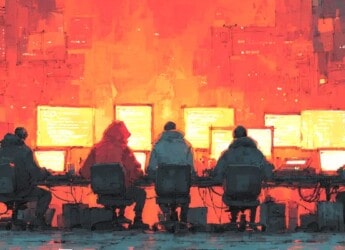Editor’s Note: The evolving fight for Pokrovsk isn’t just a battlefield update—it’s a front-line demonstration of how kinetic warfare, drone saturation, and digital disruption now converge. This article includes and complements ongoing reporting from the Institute for the Study of War (ISW), extending its operational insights into the adjacent impacts on civilian systems, sensor networks, and the resilience of information flows.
For cybersecurity, information governance, and eDiscovery professionals, this is more than a regional flashpoint. It’s a clear example of hybrid conflict where infrastructure attacks mimic cyber events, telemetry becomes targetable, and evidentiary continuity must survive outages, spoofing, and contested electromagnetic environments. The article illustrates how defenders must prepare for incidents that blur the line between digital alerts and physical destruction—and how documentation efforts must scale to preserve truth amid deliberate disruption.
As ISW has noted, both Russian and Ukrainian forces are adapting rapidly to a conflict defined by drones, attritional strikes, and sensor degradation. This piece takes those observations further—showing why organizations responsible for data integrity, legal accountability, and operational resilience can’t afford to treat these disruptions as distant or theoretical. In modern war, every networked node is in play.
For those seeking to grasp the full scope of this evolving landscape, the Institute for the Study of War’s comprehensive updates serve as an invaluable resource.
Content Assessment: Urban Combat and Digital Shadows: Pokrovsk and the Convergence of Kinetic and Information Warfare
Information - 93%
Insight - 91%
Relevance - 91%
Objectivity - 90%
Authority - 95%
92%
Excellent
A short percentage-based assessment of the qualitative benefit expressed as a percentage of positive reception of the recent article from ComplexDiscovery OÜ titled, "Urban Combat and Digital Shadows: Pokrovsk and the Convergence of Kinetic and Information Warfare."
Background Note: ComplexDiscovery’s staff offers distinctive perspectives on the Russo-Ukrainian war and Middle Eastern conflicts, informed by their military experience on the West German, East German, and Czechoslovakian borders during the Cold War, as well as in Sinai as part of Camp David Accord compliance activities, during the timeframe of the Persian Gulf War. This firsthand regional knowledge has been further enhanced by recent staff travels to Eastern European countries, including Estonia, Finland, Latvia, Lithuania, and Poland. These visits have provided up-to-date, on-the-ground insights into the current geopolitical climate in regions directly impacted by the ongoing conflict.
Combined with cybersecurity, information governance, and eDiscovery proficiency, this multifaceted experience enables comprehensive analysis of these conflicts, including the critical impact of cyber warfare, disinformation, and digital forensics on modern military engagements. This unique background positions ComplexDiscovery to provide valuable insights for conflict-related investigations and litigation, where understanding the interplay of technology, data, and geopolitical factors is crucial.
Russo-Ukrainian Conflict Update*
Urban Combat and Digital Shadows: Pokrovsk and the Convergence of Kinetic and Information Warfare
ComplexDiscovery Staff
Ukrainian special forces pierced a drone-saturated sky beginning October 31, conducting a heliborne insertion west of Pokrovsk that challenged Russian assumptions about airtight air-defense coverage. Hours later and hundreds of miles away, Berlin’s Brandenburg Airport halted traffic for nearly two hours after an unidentified drone incursion, with local media reporting multiple diversions. The juxtaposition is stark: the same class of unmanned threats shaping a street-by-street fight in eastern Ukraine is now disturbing civilian air corridors deep inside NATO airspace. Together, these episodes illuminate how modern conflict simultaneously targets physical infrastructure, sensor networks, and the integrity of information flows.
Kyiv’s operation unfolded in urban terrain where perception is often as decisive as position. Ukrainian military intelligence inserted troops by UH-60 Black Hawk into contested ground to stabilize approaches that keep Pokrovsk supplied; Moscow claimed a repulse and heavy losses, with some Russian sources reporting all members of the insertion team were eliminated by drone strikes—assertions Kyiv rejected. The tactical outcome remains disputed, but the operational question unsettled Russian commentators: how did manned helicopters penetrate an airspace believed to be under layered drone surveillance and overlapping air defenses? The answer implies seams in Russian sensing and decision cycles—an uncomfortable finding for any military banking on ubiquitous ISR—and a reminder to civilian operators that “layered security” only works if the layers talk to each other.
On the ground, Pokrovsk’s fight now pivots on digital high ground as much as urban chokepoints. A senior Ukrainian officer told domestic media that Russian troops are active across much of the city; open-source mappers at DeepState, however, still show roughly half the urban area contested. This mismatch captures the fog generated by drones, infiltration groups, and weather-bound ISR windows. When rain and fog cut aerial surveillance, Russian teams of several dozen can slip through seams; when skies clear, Ukrainian operators often pare those incursions to smaller units. Control of rooftops and elevated terrain matters because it extends the reach of first-person-view (FPV) drones to tens of kilometers, turning every high-rise into a potential launchpad and every approach road into a monitored lane. The result is a three-dimensional battlespace in which physical maneuver and digital command networks must remain synchronized—or fail together.
Russian forces have exploited that geometry to pressure Ukrainian ground lines of communication between Pokrovsk and neighboring Myrnohrad. According to Ukrainian officials, Russia has concentrated approximately 170,000 troops in the area. Drone operators, mortarmen, and relay crews in the near-rear are hunted as methodically as the riflemen on the line, forcing Ukraine to displace second-echelon operators farther back and compressing its sensor-to-shooter loops. Reports and technical analyses indicate Russia’s growing use of “mothership” Molniya UAVs that ride commercial mobile networks to carry and release FPV drones closer to targets—an adaptation that pushes FPV effects 30–40 kilometers beyond the front and demonstrates how commercial telecoms can be repurposed for battlefield reach.
Kyiv has not confined its response to the immediate urban fight. Overnight October 31–November 1, Ukraine’s military intelligence struck three lines of the 400-kilometer Koltsevoy pipeline in Moscow Oblast—an artery able, at full capacity, to move millions of tons of jet fuel, diesel, and gasoline from refineries around Ryazan, Nizhny Novgorod, and Moscow. Ukrainian officials framed the attack as a logistics strike; the targeting underscores how energy infrastructure sits squarely inside the kill chain of modern war.
Moscow answered with mass. In the same period, Russia launched 223 strike drones—about 140 Shahed-type—alongside missiles from multiple axes. Ukraine reported intercepting 206 drones, but 17 still reached targets across seven locations. An Iskander ballistic strike on Mykolaiv killed one person and injured 19; other strikes damaged gas and power facilities in central Ukraine. Interception rates headline the news, yet the systems-level effect is cumulative: grid instability, forced load-shedding, and maintenance crews operating under fire.
Those stresses were measurable on November 2, when a large outage hit Donetsk Oblast and roughly 60,000 customers in Zaporizhzhia lost power—another proof that even partially blunted salvos can impose strategic costs on energy-dependent systems. For organizations that steward sensitive data—from accountability archives to critical-infrastructure telemetry—these blackouts are not abstractions. They imperil preservation, chain of custody, and the continuity of evidence trails just as legal processes, audits, or incident responses depend on them.
The European theater’s airspace pressures are also widening. On October 31, Berlin’s BER airport suspended operations for almost two hours after drone sightings, with German outlets citing at least 11 diversions; the incident followed a month of drone-linked disruptions across European hubs. At the same time, Poland reported multiple days of interceptions of a Russian Il-20 reconnaissance aircraft over the Baltic Sea, flying without a transponder and without a filed flight plan. These are not isolated mishaps; they are iterative probes that test detection, attribution, and the legal authorities needed to neutralize unmanned intrusions.
For security leaders, Pokrovsk’s battle offers a blunt lesson about convergence. Kinetic strikes on substations, pipelines, and telecom relays can deliver effects similar to sophisticated cyber operations: degraded sensor coverage, corrupted data flows, and broken trust in common operating pictures. Defenders must plan for blended scenarios in which the “incident” is both a malware alert and a transformer fire, both a DDoS spike and a jammed RF spectrum. Resilience here means more than backups; it requires independent power, offline capture of critical telemetry, authenticated logging that survives long outages, and operational procedures that assume crews will work under contested electromagnetic conditions.
The documentation community faces its own scaling challenge. Ukraine’s Security Service has tallied nearly 160 drone-enabled strikes on Russian oil infrastructure in 2025 alone, each producing digital artifacts that could matter in future proceedings. Mnemonic’s Ukrainian Archive already hosts millions of conflict records; Ukraine’s Prosecutor General reports well over 180,000 registered war-crime incidents as of mid-September, a caseload that dwarfs the capacity of most national systems. Applying the Berkeley Protocol’s guidance on collection, preservation, and verification is essential—but in the field, it must be adapted for power failures, intermittent networks, and deliberate attempts to corrupt or spoof digital evidence.
Strategically, Russia seeks to grind forward around Pokrovsk with saturation FPV use, weather-timed infiltrations, and pressure on supply corridors; Ukraine counters with selective urban operations, reinforcement by air, and deep strikes on fuel and energy nodes. Both sides are fighting for rooftops and relay lines as much as for intersections and railheads, because information advantage now decides how quickly fires converge and how long logistics endure. The question for the coming weeks is therefore two-fold: can Ukraine preserve freedom of maneuver in and around Pokrovsk, and can the digital systems that underpin both military and civil resilience maintain integrity under the combined pressure of kinetic salvos, unmanned incursions, and information operations?
Assessed Control of Terrain Map for November 1, 2025
Russo-Ukrainian-War-November-1-2025About the Institute for the Study of War Research Methodology
ISW’s research methodology relies on both primary and secondary sources, enabling researchers to develop a comprehensive understanding of the situation on the ground. In order to analyze military and political developments in any given area, ISW’s research analysts must wholly understand the systems of enemy and friendly forces. They must also understand the population demographics, physical terrain, politics, and history of that area. This lays the analytical foundation for understanding the reasons for particular developments and fulfilling their assigned research objectives. ISW analysts also spend time in places like Iraq, Afghanistan, and elsewhere in order to gain a better understanding of the security and political situation and to evaluate the implementation of current strategies and policies. Their researchers compile data and analyze trends, producing a granular analysis of developments in areas of research, producing an accurate, high-resolution, timely, and thorough picture of the situation. ISW’s research methodology guarantees its success and commitment to improving the nation’s ability to execute military operations, achieve strategic objectives, and respond to emerging problems that may require the use of American military power.
About the Institute for the Study of War
The Institute for the Study of War advances an informed understanding of military affairs through reliable research, trusted analysis, and innovative education. They are committed to improving the nation’s ability to execute military operations and respond to emerging threats in order to achieve U.S. strategic objectives. ISW is a non-partisan, non-profit, public policy research organization.
Learn more, get involved, and contribute today.
News Sources
- Russian Offensive Campaign Assessment, November 1, 2025 (Institute for the Study of War)
- Berlin airport briefly halts flights due to drone sightings (Deutsche Welle)
- Polish jets intercepted Russian aircraft over Baltic Sea, minister says (Reuters)
- Ukraine has hit nearly 160 Russian oil facilities in 2025, SBU says (Kyiv Independent)
- HUR Special Forces Make Helicopter Landing Near Pokrovsk (Kyiv Post)
Assisted by GAI and LLM Technologies
* Sourced and shared with permission from the Institute for the Study of War (ISW).
Additional Reading
- From Dissent to OSINT? Understanding, Influencing, and Protecting Roles, Reputation, and Revenue
- Data Embassies: Sovereignty, Security, and Continuity for Nation-States
Source: ComplexDiscovery OÜ



























